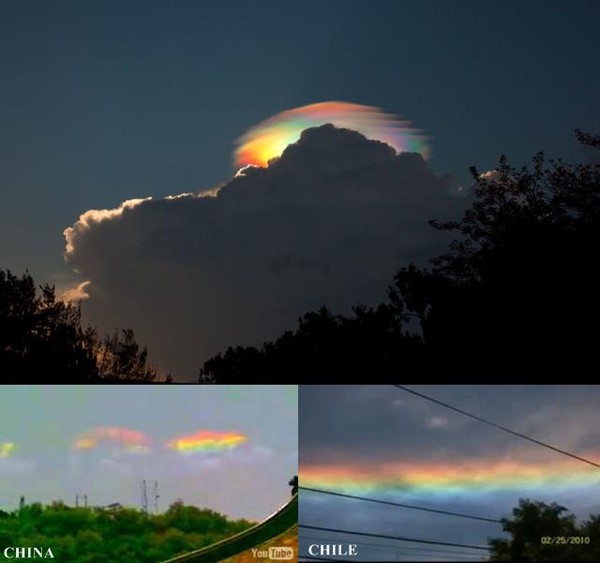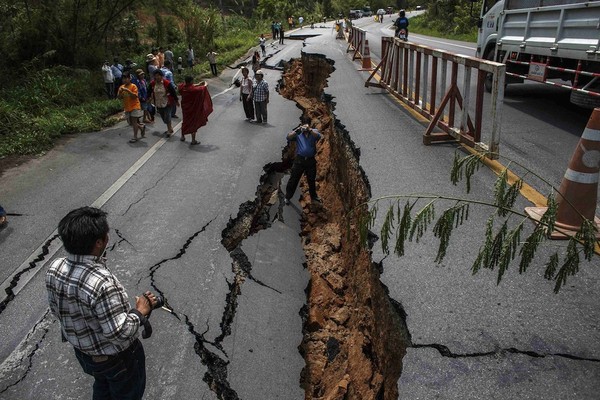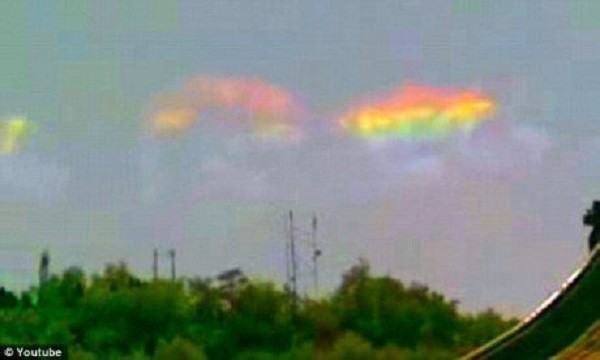5 natural foreboding before the disaster
Science has proven, when nature "becomes" or "animals are difficult" - that is when disasters are coming.
Natural disasters such as earthquakes, tsunamis . always cause tremendous losses in assets and lives. Therefore, throughout history, people have been searching for and inventing predictable tools before disasters.
However, these devices are not always completely accurate. On the contrary, in nature there are many signs for us to predict disaster - that is the unusual transformation of the sky, the earth, the ocean or simply the abnormal expression of some animals. .
1. The sky is "crazy", nature is angry
One of the natural signs related to earthquakes is the appearance of strange lights in the sky. In the scientific world, these lights are called ' Earthquake light'.

Scientific reports indicate that dynamic light often appears in the sky near areas with tremors, volcanic eruptions and earthquakes. In essence, these are the same lightings as the aurora with a white to blue spectrum.

The underground fractures are the profound source of this strange light
Earthquake light can last a few seconds or even tens of minutes depending on the case. A number of events noted the emergence of this light as the Kalapana 1975 earthquake, Sichuan earthquake, China in 2008 .

Light earthquake in the disaster in Sichuan, China in 2008
Explaining why earthquake light appeared before the disaster, Professor Troy Shinbrot of Rutgers University explained: "When an earthquake hits, cracks in the ground release electricity into the air. They ionize the part from the air and consequently causes the special light above. "
2. The ocean growled, the super earthquake slowly came
Japan is one of the countries that suffer the most natural disasters like tsunamis and earthquakes in the world. In 2011, the magnitude 9 earthquake struck the lives of 16,000 people in the country.

That is the reason why Japanese scientists are constantly researching to find out the signs of nature warning before disasters. Recently, a study published in Science shows that it seems that cherry blossoms have found the answer.
Accordingly, Japan's oceanic vibrating measuring device obtained the strange "growling" sounds of the sea. Through analysis, this sound was found to be related to the 'slow' earthquake phenomenon.

The ocean seems peaceful but hidden deep at the bottom are terrifying underground seismic
These are underground earthquakes, affected by the movement of magma currents , not causing fractures or volcanic eruptions like normal earthquakes.
However, when the number of ' slow' earthquakes becomes dense, that is the sign of an imminent earthquake. Therefore, exploring and listening to the ocean's "growl" will open new steps in predicting natural disasters.
3. The cat is hard to live in, and he is awkward
Also related to the 2011 catastrophe in Japan, expert Hiroyuki Yamauchi and his colleagues conducted an Internet survey of pet owners in search of an association between earthquakes and unusual behaviors. of animals. The survey results show that cats are the most sensitive creature to earthquakes.

Specifically, the team surveyed over 703 cat owners and was told about the strange behavior of this species. Some cats participating in the survey revealed an abnormality within 6 days or even earlier before the earthquake occurred.
They became shaky, restless and wanted to run out the door, others were extremely agitated.
Explaining these behaviors, the researchers believe that cats are species that have many times more sensitive senses than humans.
Therefore, they can sense earthquake signals such as changes in atmospheric pressure, ground deformation (changes in tilt, slope), changes in groundwater levels or substances gas and steam released from cracks .
4. Red ants 'awake', earthquakes in front of the terrace
In 2013, expert Gabriele Berberich from Duisburg-Essen University (Germany) presented a study in Vienna demonstrating the ability to predict earthquakes of red ants.

Within three years (2009 - 2012), Berberich and his colleagues followed about 15,000 red ants living in areas that were located on underground fault lines in Germany.
They used cameras to record ant behavior 24/7, then contrasted with 10 small earthquakes (2 - 3.2 Richter levels) in the corresponding time and they discovered something strange.

The red ants are observed and watched by Berberich
Normally, red ants work during the day and at night will return to the nest. However, one day before the earthquakes, all the red ants were awake all night, not returning to the nest . Everything just returned to normal after the earthquake passed.

Berberich and his colleagues believe that it is evidence of the small animal's ability to alert earthquakes. She said many red ants possessed special nerve receptors that helped them identify the changes in the amount of gas in the ground as well as change the Earth's magnetic field. Thus, they can predict when earthquakes will occur.
5. Where the storm is, sharks "go"
Until now, the majority of animals when they felt a disaster in an area, the first thing they wanted was to avoid as far as possible. However, sharks are the opposite.
Scientific observations show that sharks seem to be a storm hunter in nature. The waters suddenly crowded with sharks that will be a premonition for a strong storm about to form.

Where there are storms .
This observation has been attested by Professor Neil Hammerschlag. In Miami University's Marine Life Conservation project, he tagged about 300 sharks a year and monitored them.
Hammerschlag found that tagged sharks love to swim to rapidly changing temperatures. In other words, these are the sea areas originating for storms on the ocean.

. where sharks will come to roll
From this discovery, Hammerschlag proposed shark tracking to predict where storms were formed and developed . These will be extremely economical and highly efficient storm forecasters.
According to him, ' the best thing is that sharks are the owners of the ocean because they can swim to places where humans cannot reach and gather data about that place'.
- Close to the horrific earthquake in Ecuador that killed 246 people
- Approving the natural disaster prevention, fighting and reduction strategy till 2020
- Thailand: A model for effective flood disaster response
- The worst natural disasters in 2015
- Australia is trying to overcome the consequences of natural disasters
- New Zealand helps Vietnam respond to natural disasters
- 2010 - the number of people killed by unusually high natural disasters
- Natural disaster in 2008 through photos
- World conference on disaster mitigation in Japan
- Disaster disaster
- Strange phenomena after a disaster
- Indonesia announced a report of damage caused by natural disasters
 Is the magnetic North Pole shift dangerous to humanity?
Is the magnetic North Pole shift dangerous to humanity? Washington legalizes the recycling of human bodies into fertilizer
Washington legalizes the recycling of human bodies into fertilizer Lightning stone - the mysterious guest
Lightning stone - the mysterious guest Stunned by the mysterious sunset, strange appearance
Stunned by the mysterious sunset, strange appearance